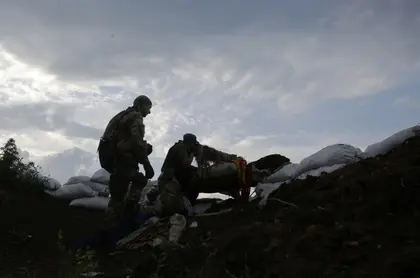Part of the village sits on higher ground that could be used as a vantage
point from which to launch an attack on Mariupol, the region’s second largest
city after Donetsk. Thus, Shyrokyne has been an epicenter of fighting in recent
months, leaving most of the village in ruins and devoid of its residents, who have
long since fled.
Many residents of Mariupol, which had a pre-war population of 500,000, now
believe the pullout endangers their city. Volunteer fighters have already vowed
to stay put if new fighting erupts, and Mariupol residents have set up tents in
front of the city administration building to protest against the pullout from
Shyrokyne.
JOIN US ON TELEGRAM
Follow our coverage of the war on the @Kyivpost_official.
Both the Azov Regiment and the Donbass Battalion – which held their
positions in the city for several months during some of the most intense
fighting – have now left the village. But they refused to do so quietly.
Yevhen Shevchenko, a
fighter from the Donbas Battalion, took to social media to complain that the
replacement troops were poorly equipped, “young and inexperienced, most of them
are on the frontline for the first time.”
Andriy Biletsky, a lawmaker and commander of the Azov Battalion, issued
a stark warning that “if Ukraine is ready to surrender Shyrokyne, then we have
to be prepared for the loss of Mariupol too.”
He urged authorities not to “give in to the dictate of international
institutions,” a reference to the Organization for Security and Cooperation in
Europe, which has been calling for the demilitarization of Shyrokyne for months.
In early July, international monitors lamented the fact that there was
no demilitarization plan for Shyrokyne. Alexander Hug, the deputy head of the
special monitoring mission of the OSCE, said at the time that demilitarization
of the town would help “build trust” in fulfilling the Minsk peace agreement
reached in February.
But on July 27, the same day the pullout was announced, an international
monitor from the organization was wounded in further shelling in Shyrokyne,
further fueling fears that the move is premature.
Residents of Mariupol have been up in arms about the decision since it
was first announced on July 26, and set up the protest camp in the center of
the city to show that they are “worried about their safety,” according to Maria
Podybaylo, the coordinator of New Mariupol, a nongovernmental organization.
At a briefing in Kyiv on July 28, Podybaylo implied that Poroshenko was making empty promises by
reassuring residents that Mariupol would not be part of the planned buffer
zone.
“The distance
from Shyrokyne to the 14th security roadblock (at the edge of Mariupol) is
10 kilometers. If the buffer zone is 25 kilometers, the entire city of Mariupol
would be inside it,” Podybaylo said.
A day earlier, Poroshenko had sought to ease the fears of residents in
Mariupol, saying that “we will never give it (the city) up to anyone.”
“I would like to tell the residents of Mariupol – the president is with
you, the armed forces are with you, the best representatives (of the military),
including land forces, the Marines and artillery units – they are with you. The
buffer zone does not relate to Mariupol,” Poroshenko said.
Andriy Lysenko, the presidential spokesman for issues relating to the
war zone, echoed the president’s statements at another briefing in Kyiv on July
28, saying that the new troops stationed in Shryokyne “are at full combat
readiness.”
“We ask you not
to panic – Mariupol and Shyrokyne have been and will be under the control of
Ukrainian forces,” Lysenko said. “The agreement about the
buffer zone hasn’t been signed yet. When it is signed, it will mean that both
sides have to withdraw heavy artillery 15 kilometers from Shyrokyne on each
side. If the enemy doesn’t withdraw the artillery, and continues to violate the
agreement, we won’t leave our positions open.”
A rapid response
unit will also be prepared to react should fighting escalate, Lysenko said.
But activists
and soldiers seem unwilling to take the president at his word.
Spartak Stepnov, an activist of the
pro-Ukrainian New Mariupol group’s self-defense unit, questioned the wisdom of
the pullout at the first briefing in Kyiv, saying that Ukraine had already lost
enough territory.
“The people in
Mariupol made a clear decision – we can’t let the war into our city,” Stepnov said. “We’re ready to defend the
city. Our self-defense unit wants to
join the OSCE group and head to Shyrokyne. If the president is right, then we
are safe. If not, we will stand at our positions, where the volunteer
battalions have been stationed.”
Military expert
Oleksiy Melnyk of the Razumkov Center said Mariupol residents had plenty of
reason to be concerned.
“I would remind
those who believe in this decision’s positive contribution to resolving the
conflict that the terms of the previous Minsk agreement were never
implemented,” Melnyk said.
“Russia doesn’t
want to consider itself a party in the conflict,” he added, noting that Russia
had previously used the Minsk agreements to its own advantage.
“These fears
(that Ukraine might lose more territory) aren’t groundless. But, again, maybe
we don’t know about some super powerful strategy that is being planned in the
high-ranking offices,” Melnyk said.
Staff writer Allison
Quinn can be reached at [email protected]
Staff
writer Alyona Zhuk can be reached at [email protected]
You can also highlight the text and press Ctrl + Enter




